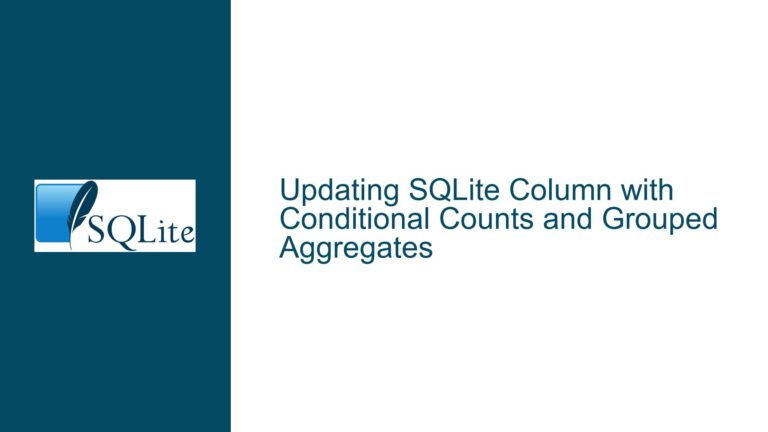Why REPLACE Bypasses UPDATE Triggers in SQLite and How to Enforce Constraints
Issue Overview: Trigger Behavior Discrepancies Between REPLACE and UPDATE Operations
SQLite’s conflict resolution mechanisms, such as INSERT OR REPLACE, are designed to handle constraint violations by deleting and reinserting rows instead of directly updating them. This creates an apparent inconsistency when developers implement triggers to restrict modifications to a table. For example, a BEFORE UPDATE trigger designed to block row modifications may not fire when INSERT OR REPLACE is used, even though the operation appears to modify existing data. The root of this behavior lies in how SQLite internally processes REPLACE operations: they are implemented as a DELETE followed by an INSERT, not as an UPDATE. Consequently, the BEFORE UPDATE trigger does not activate during a REPLACE operation.
This discrepancy becomes problematic when developers rely on triggers to enforce business logic or data integrity constraints. A common scenario involves creating BEFORE UPDATE and BEFORE DELETE triggers to prevent unauthorized modifications. When INSERT OR REPLACE is executed, the expectation is that either the UPDATE or DELETE trigger will block the operation. However, the UPDATE trigger remains inactive, and the DELETE trigger may also fail to activate unless specific conditions are met. This creates a loophole where data can be modified despite the presence of safeguards.
The core issue revolves around two interrelated factors:
- Conflict Resolution Strategy: The
REPLACEkeyword is a conflict resolution clause that handles unique constraint violations by deleting the conflicting row and inserting a new one. This bypasses theUPDATEtrigger because noUPDATEoccurs. - Trigger Activation Rules: By default, SQLite does not activate
DELETEtriggers duringREPLACEoperations unless therecursive_triggerspragma is enabled. This leads to silent data modifications when triggers are not configured to account for this edge case.
Understanding these mechanics is critical for diagnosing why REPLACE operations evade trigger-based constraints and how to adjust the database configuration to enforce the intended restrictions.
Possible Causes: REPLACE Mechanics and Trigger Configuration Oversights
The unexpected behavior of INSERT OR REPLACE bypassing BEFORE UPDATE triggers stems from a combination of SQLite’s conflict resolution design and default trigger execution settings. Below are the primary factors contributing to this issue:
1. REPLACE Operates as DELETE+INSERT, Not UPDATE
The REPLACE conflict resolution strategy is not a direct update but a two-step process:
- Step 1: Attempt to insert a new row. If a uniqueness constraint violation occurs (e.g., duplicate primary key), the conflicting row is deleted.
- Step 2: Insert the new row into the table.
Since no UPDATE statement is executed, the BEFORE UPDATE trigger does not activate. The operation instead involves a DELETE and an INSERT, which means only BEFORE DELETE and BEFORE INSERT triggers are relevant. If the BEFORE DELETE trigger is absent or not configured to block deletions, the REPLACE operation proceeds without hindrance.
2. Recursive Triggers Disabled by Default
SQLite’s recursive_triggers pragma controls whether triggers can activate other triggers (directly or indirectly). When this setting is disabled (the default), DELETE triggers do not fire during REPLACE operations. This is a deliberate optimization to prevent infinite recursion in certain scenarios. However, it also means that a BEFORE DELETE trigger designed to block deletions will not activate during a REPLACE unless recursive_triggers is explicitly enabled.
3. Misalignment Between Trigger Logic and Conflict Resolution
Developers often assume that REPLACE is semantically equivalent to an UPDATE, leading to incorrect expectations about trigger activation. For example, a table with a BEFORE UPDATE trigger to block modifications and a BEFORE DELETE trigger to block deletions might still allow REPLACE operations if the DELETE trigger does not account for deletions caused by conflict resolution.
4. Overlooking the Role of Constraints
The REPLACE strategy is only invoked when a uniqueness constraint is violated. If the table lacks such constraints, INSERT OR REPLACE behaves as a plain INSERT, further complicating the relationship between triggers and conflict resolution.
Troubleshooting Steps, Solutions & Fixes: Enforcing Trigger Activation for REPLACE Operations
To ensure that INSERT OR REPLACE operations are blocked by triggers, follow these steps to diagnose and resolve the issue:
1. Verify Trigger Coverage for DELETE and INSERT Events
Since REPLACE involves a DELETE and INSERT, the BEFORE UPDATE trigger is irrelevant. Instead, ensure that a BEFORE DELETE trigger exists to block deletions. For example:
CREATE TRIGGER reject_delete_matrix_super_classes_log
BEFORE DELETE ON matrix_super_classes_log
BEGIN
SELECT RAISE(ABORT, 'DELETEs are not allowed!');
END;
This trigger will block any explicit DELETE statements. However, it will not activate during REPLACE operations unless recursive triggers are enabled.
2. Enable Recursive Triggers
Modify the database connection to enable recursive triggers using the recursive_triggers pragma:
PRAGMA recursive_triggers = 1;
This setting allows the BEFORE DELETE trigger to activate during the DELETE phase of a REPLACE operation. With this enabled, the REPLACE will be aborted because the BEFORE DELETE trigger raises an error.
3. Analyze Conflict Resolution Requirements
If REPLACE is being used to handle constraint violations, consider alternative strategies that align with trigger logic:
- Use
INSERT OR IGNOREto skip rows that violate constraints. - Use
INSERT OR UPDATE(SQLite version 3.35.0+) to explicitly triggerBEFORE UPDATEevents.
4. Replace REPLACE with Explicit UPDATE Statements
Refactor application code to avoid INSERT OR REPLACE entirely. Instead, use separate UPDATE and INSERT statements wrapped in a transaction. This ensures that BEFORE UPDATE triggers activate when modifications occur:
BEGIN TRANSACTION;
UPDATE matrix_super_classes_log SET ... WHERE id = ?;
-- If no rows were updated:
INSERT INTO matrix_super_classes_log ...;
COMMIT;
5. Implement Composite Triggers for DELETE and INSERT
If REPLACE cannot be avoided, create additional triggers to monitor INSERT events that follow a DELETE:
CREATE TRIGGER reject_replace_matrix_super_classes_log
AFTER DELETE ON matrix_super_classes_log
FOR EACH ROW
BEGIN
SELECT RAISE(ABORT, 'REPLACE operations are not allowed!')
WHERE EXISTS (
SELECT 1 FROM matrix_super_classes_log
WHERE id = NEW.id
);
END;
This trigger checks if a new row with the same primary key is inserted immediately after a deletion, which is indicative of a REPLACE operation.
6. Audit Uniqueness Constraints
Ensure that uniqueness constraints are correctly defined. If REPLACE is not necessary, consider removing or relaxing constraints to allow simpler INSERT operations.
7. Use Application-Layer Validation
Supplement database triggers with application-layer checks to prevent REPLACE statements from being executed. This provides an additional safeguard against unintended data modifications.
By systematically addressing the interaction between conflict resolution strategies and trigger configurations, developers can enforce consistent data integrity rules across all modification operations in SQLite.





